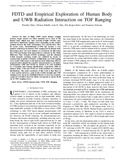Mostrar el registro sencillo del ítem
FDTD and empirical exploration of human body and UWB radiation interaction on TOF ranging
| dc.creator | Otim, Timothy | es_ES |
| dc.creator | Bahillo, Alfonso | es_ES |
| dc.creator | Díez, Luis E. | es_ES |
| dc.creator | López Iturri, Peio | es_ES |
| dc.creator | Falcone Lanas, Francisco | es_ES |
| dc.date.accessioned | 2024-01-19T07:35:57Z | |
| dc.date.available | 2024-01-19T07:35:57Z | |
| dc.date.issued | 2019 | |
| dc.identifier.citation | Otim, T., Bahillo, A., Diez, L. E., Lopez-Iturri, P., & Falcone, F. (2019). Fdtd and empirical exploration of human body and uwb radiation interaction on tof ranging. IEEE Antennas and Wireless Propagation Letters, 18(6), 1119-1123. https://doi.org/10.1109/LAWP.2019.2910378 | en |
| dc.identifier.issn | 1536-1225 | |
| dc.identifier.uri | https://hdl.handle.net/2454/47044 | |
| dc.description.abstract | In time-of-flight (TOF)-based human ranging systems, target sensors are often mounted on or close to the human body, which may raise non-line-of-sight (NLOS) cases and lead to significant ranging errors depending on the relative position between the body, transmitter (Tx), and receiver (Rx). In recent years, ultrawideband (UWB) has become a very popular technology for human TOF ranging, but its human body interactions have not been studied yet extensively. In this letter, the UWB and human body interaction is explored by the finite-difference time-domain (FDTD) technique, and the obtained E-field strength variation results are validated by means of commercially available UWB kits. Additionally, an UWB-ranging error model with respect to the human body shadowing effect is proposed and evaluated by extensive measurements, i.e., in indoor environments, line-of-sight (LOS) and NLOS are found to be well modeled by Gaussian and Gamma distributions, respectively, while in outdoor fields, LOS and NLOS are both modeled by Gaussian distributions. The main conclusion of this study is that there is a clear pattern between a gain in the E-field strength and TOF ranging errors. It can be established that in a worst-case scenario, a gain of 4–18 dB is observed, which corresponds to about 30–60 cm of TOF ranging errors. | en |
| dc.format.mimetype | application/pdf | en |
| dc.language.iso | eng | en |
| dc.publisher | IEEE | en |
| dc.relation.ispartof | IEEE Antennas and Wireless Propagation Letters, 18(6) 1119-1123 | en |
| dc.rights | © 2019 IEEE. Personal use of this material is permitted. Permission from IEEE must be obtained for all other uses, in any current or future media, including reprinting/republishing this material for advertising or promotional purposes, creating new collective works, for resale or redistribution to servers or lists, or reuse of any copyrighted component of this work in other work. | en |
| dc.subject | FDTD | en |
| dc.subject | Human body | en |
| dc.subject | UWB | en |
| dc.subject | TOF | en |
| dc.subject | Ranging | en |
| dc.title | FDTD and empirical exploration of human body and UWB radiation interaction on TOF ranging | en |
| dc.type | Artículo / Artikulua | es |
| dc.type | info:eu-repo/semantics/article | en |
| dc.date.updated | 2024-01-19T07:23:11Z | |
| dc.contributor.department | Ingeniería Eléctrica, Electrónica y de Comunicación | es_ES |
| dc.contributor.department | Institute of Smart Cities - ISC | en |
| dc.contributor.department | Ingeniaritza Elektrikoa, Elektronikoaren eta Telekomunikazio Ingeniaritzaren | eu |
| dc.rights.accessRights | Acceso abierto / Sarbide irekia | es |
| dc.rights.accessRights | info:eu-repo/semantics/openAccess | en |
| dc.identifier.doi | 10.1109/LAWP.2019.2910378 | |
| dc.relation.publisherversion | https://doi.org/10.1109/LAWP.2019.2910378 | |
| dc.type.version | Versión aceptada / Onetsi den bertsioa | es |
| dc.type.version | info:eu-repo/semantics/acceptedVersion | en |


